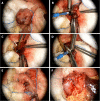Microscopic transduodenal excision of an ampullary adenoma: A case report and review of the literature
- PMID: 34222457
- PMCID: PMC8223850
- DOI: 10.12998/wjcc.v9.i18.4844
Microscopic transduodenal excision of an ampullary adenoma: A case report and review of the literature
Abstract
Background: Transduodenal local excision is an alternative treatment approach for benign ampullary tumors. However, this procedure has technical difficulties, especially during reconstruction of the pancreaticobiliary ducts. An operating microscope has been widely used by surgeons for delicate surgery due to its major advantages of magnification, illumination, and stereoscopic view. The application of an operating microscope in transduodenal excision of ampullary tumors has not been reported.
Case summary: A 55-year-old woman was admitted for investigation of recurrent upper abdominal pain. Physical examination and laboratory tests found no abnormalities. Imaging identified a large mass in the descending part of the duodenum. Esophagogastroduodenoscopy revealed a 3.5-cm-sized villous growth over the major duodenal papilla. Pathology of the endoscopic biopsy indicated a villous adenoma with low-grade dysplasia. Microscopic transduodenal excision of the ampullary tumor was performed. The final pathological diagnosis was villous-tubular adenoma with low-grade dysplasia. The patient was discharged on postoperative day 12 after an uneventful recovery. Endoscopic retrograde cholangiopancreatography was performed 3 mo postoperatively and showed no bile duct or pancreatic duct strictures and no tumor recurrence. The patient is continuing follow-up at our clinic and remains well.
Conclusion: Operating microscope-assisted transduodenal local excision is a feasible and effective option for benign ampullary tumors.
Keywords: Ampullary tumor; Case report; Endoscopic papillectomy; Operating microscope; Pancreaticoduodenectomy; Transduodenal local excision.
©The Author(s) 2021. Published by Baishideng Publishing Group Inc. All rights reserved.
Conflict of interest statement
Conflict-of-interest statement: The authors declare that they have no conflict of interest to report.
Figures


Similar articles
-
Laparoscopic Transduodenal Ampullectomy: How We Have Standardized the Technique (with Video).Ann Surg Oncol. 2023 Feb;30(2):1156-1157. doi: 10.1245/s10434-022-12867-5. Epub 2022 Dec 12. Ann Surg Oncol. 2023. PMID: 36509879
-
Laparoscopic resection of a periampullary villous adenoma.Surg Endosc. 2003 Aug;17(8):1322-3. doi: 10.1007/s00464-002-4527-4. Epub 2003 Jun 13. Surg Endosc. 2003. PMID: 12799897
-
Laparoscopy-assisted transduodenal excision of superficial non-ampullary duodenal epithelial tumors.Asian J Endosc Surg. 2015 Aug;8(3):310-5. doi: 10.1111/ases.12191. Epub 2015 May 7. Asian J Endosc Surg. 2015. PMID: 25950619
-
[Adenomas of Vater's ampulla and of the duodenum. Presentation of diagnosis and therapy by endoscopic interventional and surgical methods].Chirurg. 2002 Mar;73(3):235-40. doi: 10.1007/s00104-001-0401-5. Chirurg. 2002. PMID: 11963497 Review. German.
-
Still any role for transduodenal local excision in tumors of the papilla of Vater?J Hepatobiliary Pancreat Surg. 2004;11(4):239-44. doi: 10.1007/s00534-004-0896-5. J Hepatobiliary Pancreat Surg. 2004. PMID: 15368107 Review.
References
-
- El Hajj II, Coté GA. Endoscopic diagnosis and management of ampullary lesions. Gastrointest Endosc Clin N Am. 2013;23:95–109. - PubMed
-
- Seifert E, Schulte F, Stolte M. Adenoma and carcinoma of the duodenum and papilla of Vater: a clinicopathologic study. Am J Gastroenterol. 1992;87:37–42. - PubMed
-
- Posner S, Colletti L, Knol J, Mulholland M, Eckhauser F. Safety and long-term efficacy of transduodenal excision for tumors of the ampulla of Vater. Surgery. 2000;128:694–701. - PubMed
Publication types
LinkOut - more resources
Full Text Sources

